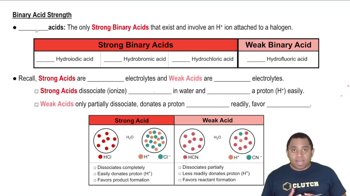Here are the essential concepts you must grasp in order to answer the question correctly.
Acid Strength
Acid strength refers to the ability of an acid to donate protons (H+) in a solution. Stronger acids dissociate more completely in water, resulting in a higher concentration of H+ ions. The strength of an acid can be quantified using the acid dissociation constant (Ka), where a larger Ka value indicates a stronger acid.
Recommended video:
Ammonium Ion (NH4+)
The ammonium ion (NH4+) is a positively charged ion formed when ammonia (NH3) accepts a proton. It acts as a weak acid in aqueous solutions, capable of donating a proton to form ammonia. Understanding its behavior in acid-base reactions is crucial for comparing its strength to other acids.
Recommended video:
Hydroxylammonium Ion (NH3OH+)
The hydroxylammonium ion (NH3OH+) is derived from hydroxylamine and can also donate a proton, functioning as an acid. Its strength relative to the ammonium ion can be assessed by comparing their respective Ka values. The presence of the hydroxyl group in hydroxylammonium can influence its acidity due to potential resonance stabilization.
Recommended video:
 Verified step by step guidance
Verified step by step guidance


